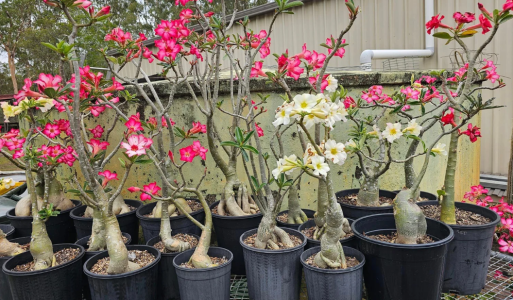Attention Aussies: You Could be Growing a Toxic Killer in Your Backyard!
By
Gian T
- Replies 8
Australia is a land of diverse flora, with many homeowners taking pride in their lush gardens filled with a variety of plants. Among these, the desert rose (Adenium obesum) stands out with its swollen stem and vibrant flowers, making it a popular choice for those with a green thumb. But beneath its beauty lies a hidden danger that every Australian gardener should be aware of.
The desert rose, while exotic and alluring, harbors a toxic secret in its sap that can pose serious health risks. This plant, which is native to regions such as the Arabian Peninsula and Africa, has found its way into many Australian gardens, often without the knowledge of its toxic potential.
Dermot Molloy, a horticulturist with the Royal Botanic Gardens Victoria, has raised the alarm about the desert rose's toxicity. As a member of the Apocynaceae family, I know that the desert rose contains a poisonous sap that can be dangerous if ingested or if it comes into contact with the eyes. This revelation has stunned many Aussie gardeners, especially after a Queensland nursery highlighted the plant's toxicity in a Facebook post that sparked widespread concern.
The desert rose's sap is described as a watery or milky latex containing toxic alkaloids, specifically cardiac glycosides. These substances can have severe effects on both humans and animals. Damian Wrigley, manager of living collections and conservation at the Botanic Gardens of Sydney, warns that all parts of the plant contain these toxic compounds. Ingestion can lead to symptoms such as an upset stomach, reduced blood pressure, dizziness, lethargy, and a slow heart rate.
Given the risks, it's crucial that the desert rose is kept out of reach of children, pets, and other animals. The plant's enticing appearance can easily lure the curious, making it imperative to exercise caution and ensure it is planted in a safe location.
Moreover, as an introduced species, there is a responsibility to prevent the desert rose from escaping domestic gardens and becoming an environmental pest. The most responsible approach, as suggested by experts, is to keep desert roses contained within a well-maintained garden or in a pot. Interestingly, the species is known to thrive when kept as a bonsai, which could be a safer and equally beautiful way to enjoy its presence.
For those who already have a desert rose in their garden, it's important to handle it with care. Mr Molloy advises using gloves and eye protection when pruning to avoid any contact with the toxic sap. Awareness and proper handling can help mitigate the risks associated with this otherwise stunning plant.
As members of the Seniors Discount Club, we encourage you to share this information with fellow garden enthusiasts and to take the necessary precautions if you have a desert rose in your garden. It's always better to be safe than sorry, especially regarding the well-being of our loved ones and pets.
 Do you have any experiences with desert roses or other toxic plants in your garden? Have you taken any special measures to ensure safety? We'd love to hear your stories and tips in the comments below. Remember, gardening is a joyous activity, but it's always wise to stay informed about the plants we nurture in our backyards.
Do you have any experiences with desert roses or other toxic plants in your garden? Have you taken any special measures to ensure safety? We'd love to hear your stories and tips in the comments below. Remember, gardening is a joyous activity, but it's always wise to stay informed about the plants we nurture in our backyards.
The desert rose, while exotic and alluring, harbors a toxic secret in its sap that can pose serious health risks. This plant, which is native to regions such as the Arabian Peninsula and Africa, has found its way into many Australian gardens, often without the knowledge of its toxic potential.
Dermot Molloy, a horticulturist with the Royal Botanic Gardens Victoria, has raised the alarm about the desert rose's toxicity. As a member of the Apocynaceae family, I know that the desert rose contains a poisonous sap that can be dangerous if ingested or if it comes into contact with the eyes. This revelation has stunned many Aussie gardeners, especially after a Queensland nursery highlighted the plant's toxicity in a Facebook post that sparked widespread concern.
The desert rose's sap is described as a watery or milky latex containing toxic alkaloids, specifically cardiac glycosides. These substances can have severe effects on both humans and animals. Damian Wrigley, manager of living collections and conservation at the Botanic Gardens of Sydney, warns that all parts of the plant contain these toxic compounds. Ingestion can lead to symptoms such as an upset stomach, reduced blood pressure, dizziness, lethargy, and a slow heart rate.
Given the risks, it's crucial that the desert rose is kept out of reach of children, pets, and other animals. The plant's enticing appearance can easily lure the curious, making it imperative to exercise caution and ensure it is planted in a safe location.
Moreover, as an introduced species, there is a responsibility to prevent the desert rose from escaping domestic gardens and becoming an environmental pest. The most responsible approach, as suggested by experts, is to keep desert roses contained within a well-maintained garden or in a pot. Interestingly, the species is known to thrive when kept as a bonsai, which could be a safer and equally beautiful way to enjoy its presence.
For those who already have a desert rose in their garden, it's important to handle it with care. Mr Molloy advises using gloves and eye protection when pruning to avoid any contact with the toxic sap. Awareness and proper handling can help mitigate the risks associated with this otherwise stunning plant.
As members of the Seniors Discount Club, we encourage you to share this information with fellow garden enthusiasts and to take the necessary precautions if you have a desert rose in your garden. It's always better to be safe than sorry, especially regarding the well-being of our loved ones and pets.
Key Takeaways
- The desert rose (Adenium obesum), popular among Australian gardeners, contains a toxic sap that is dangerous if ingested or comes into contact with eyes.
- A horticulturist from the Royal Botanic Gardens Victoria advised using gloves and eye protection when pruning the plant.
- While admired for its beauty, many people are unaware of the desert rose's toxicity, a fact highlighted by a Queensland nursery.
- The plant should be kept away from children and pets, and to prevent it from becoming a pest, it's best maintained in a contained garden or as a bonsai.








